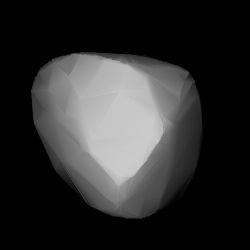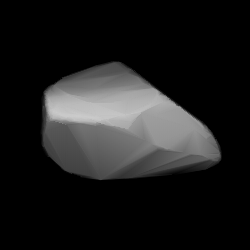Related Research Articles
2127 Tanya, provisional designation 1971 KB1, is a carbonaceous asteroid from the outer region of the asteroid belt, approximately 40 kilometers in diameter. It was discovered on 29 May 1971, by Russian astronomer Lyudmila Chernykh at the Crimean Astrophysical Observatory in Nauchnij, on the Crimean peninsula. It was named in memory of Tanya Savicheva, a Russian child diarist during World War II.
1766 Slipher, provisional designation 1962 RF, is a Paduan asteroid from the central regions of the asteroid belt, approximately 18 kilometers in diameter. It was discovered on 7 September 1962, by astronomers of the Indiana Asteroid Program at Goethe Link Observatory in Indiana, United States. The asteroid was named after American astronomers Vesto Slipher and his brother Earl C. Slipher.

1073 Gellivara, provisional designation 1923 OW, is a dark Themistian asteroid, approximately 27 kilometers in diameter, located in the outer regions of the asteroid belt. It was discovered by Austrian astronomer Johann Palisa at the Vienna Observatory on 14 September 1923, and later named after the Swedish town of Gällivare.

1032 Pafuri, provisional designation 1924 SA, is a dark background asteroid from the outer regions of the asteroid belt, approximately 65 kilometers in diameter. It was discovered on 30 May 1924, by English astronomer Harry Edwin Wood at the Union Observatory in Johannesburg, South Africa. The asteroid was named for the river in the Pafuri Triangle in South Africa, created by the confluence of the Limpopo and Levubu rivers. The body's spectral type and rotation period are still poorly determined.
1059 Mussorgskia, provisional designation 1925 OA, is a background asteroid from the central regions of the asteroid belt, approximately 25 kilometers in diameter. It was discovered on 19 July 1925, by Soviet astronomer Vladimir Albitsky at the Simeiz Observatory on the Crimean peninsula. The asteroid was named for Russian composer Modest Mussorgsky. The X- or C-type asteroid has a rotation period of 5.636 hours.

1165 Imprinetta, provisional designation 1930 HM, is a carbonaceous Meliboean asteroid from the outer regions of the asteroid belt, approximately 49 kilometers (30 mi) in diameter. It was discovered on 24 April 1930 by Dutch astronomer Hendrik van Gent at the Union Observatory in Johannesburg, South Africa. The asteroid was named after Imprinetta Gent, wife of the discoverer.
1783 Albitskij, provisional designation 1935 FJ, is a carbonaceous Adeonian asteroid from the middle region of the asteroid belt, approximately 22 kilometers in diameter. It was discovered on 24 March 1935, by Georgian–Russian astronomer Grigory Neujmin at the Simeiz Observatory on the Crimean peninsula. The asteroid was named after Soviet astronomer Vladimir Albitzky.
1541 Estonia, provisional designation 1939 CK, is an asteroid from the central regions of the asteroid belt, approximately 21 kilometers in diameter. It was discovered on 12 February 1939, by astronomer Yrjö Väisälä at the Iso-Heikkilä Observatory near Turku, Finland. The asteroid was named after the Baltic country of Estonia.
1267 Geertruida, provisional designation 1930 HD, is a carbonaceous background asteroid from the inner regions of the asteroid belt, approximately 20 kilometers in diameter. Discovered by astronomer Hendrik van Gent at Johannesburg Observatory in 1930, the asteroid was later named after Geertruid Pels, sister of Dutch astronomer Gerrit Pels.
1308 Halleria, provisional designation 1931 EB, is a carbonaceous Charis asteroid from the outer regions of the asteroid belt, approximately 43 kilometers in diameter. It was discovered on 12 March 1931, by German astronomer Karl Reinmuth at the Heidelberg-Königstuhl State Observatory. The asteroid was named after Albrecht von Haller a Swiss physician, botanist and poet.
2016 Heinemann, provisional designation 1938 SE, is a carbonaceous Themistian asteroid from the outer regions of the asteroid belt, approximately 22 kilometers in diameter. It was discovered on 18 September 1938, by German astronomer Alfred Bohrmann at Heidelberg Observatory in southwest Germany, and later named after ARI-astronomer Karl Heinemann (1898–1970).
1233 Kobresia, provisional designation 1931 TG2, is a carbonaceous background asteroid from the central regions of the asteroid belt, approximately 33 kilometers in diameter. It was discovered on 10 October 1931, by German astronomer Karl Reinmuth at the Heidelberg Observatory in southwest Germany. The asteroid was named for the grass-like flowering plant Kobresia, a genus in the sedge family.
4944 Kozlovskij, provisional designation 1987 RP3, is a carbonaceous Witt asteroid from the central regions of the asteroid belt, approximately 10 kilometers (6 miles) in diameter. It was discovered on 2 September 1987, by Soviet astronomer Lyudmila Chernykh at the Crimean Astrophysical Observatory in Nauchnij, on the Crimean Peninsula. The asteroid was named for Russian opera singer Ivan Kozlovsky.
2043 Ortutay, provisional designation 1936 TH, is a dark asteroid from the outer regions of the asteroid belt, approximately 45 kilometers in diameter. The asteroid was discovered by Hungarian astronomer György Kulin at the Konkoly Observatory, Budapest, on 12 November 1936. It was named after Hungarian ethnographer Gyula Ortutay.
1258 Sicilia, provisional designation 1932 PG, is a dark background asteroid from the outer regions of the asteroid belt, approximately 44 kilometers in diameter. It was discovered on 8 August 1932, by astronomer Karl Reinmuth at the Heidelberg-Königstuhl State Observatory in southwest Germany. The asteroid was named after the Italian island of Sicily.
1628 Strobel, provisional designation 1923 OG, is a carbonaceous asteroid from the outer region of the asteroid belt, approximately 55 kilometers in diameter.
2169 Taiwan, provisional designation 1964 VP1, is a carbonaceous Astridian asteroid from the central regions of the asteroid belt, approximately 17 kilometers in diameter. It was discovered on 9 November 1964, by astronomers at the Purple Mountain Observatory near Nanking, China. It was named for Taiwan.
1585 Union, provisional designation 1947 RG, is a dark background asteroid from the outer regions of the asteroid belt, approximately 52 kilometers in diameter. It was discovered on 7 September 1947, by South African astronomer Ernest Johnson at the Union Observatory in Johannesburg, South Africa. The asteroid was named after the discovering observatory.

1301 Yvonne is a carbonaceous background asteroid from the background population of the intermediate asteroid belt, approximately 21 kilometers in diameter. It was discovered on 7 March 1934, by French astronomer Louis Boyer at the Algiers Observatory in North Africa. The asteroid was named for the discoverer's sister, Yvonne Boyer

1546 Izsák, provisional designation 1941 SG1, is a background asteroid from the outer regions of the asteroid belt, approximately 27 kilometers in diameter. It was discovered on 28 September 1941, by Hungarian astronomer György Kulin at the Konkoly Observatory near Budapest, Hungary. The asteroid was named after Hungarian astronomer Imre Izsák.
References
- 1 2 3 4 5 "5592 Oshima (1990 VB4)". Minor Planet Center. Retrieved 14 June 2018.
- 1 2 3 "JPL Small-Body Database Browser: 5592 Oshima (1990 VB4)" (2017-10-30 last obs.). Jet Propulsion Laboratory . Retrieved 14 June 2018.
- 1 2 3 4 5 6 "Asteroid 5592 Oshima". Small Bodies Data Ferret. Retrieved 14 June 2018.
- 1 2 "Asteroid (5592) Oshima – Proper elements". AstDyS-2, Asteroids – Dynamic Site. Retrieved 13 June 2018.
- 1 2 3 Masiero, Joseph R.; Mainzer, A. K.; Grav, T.; Bauer, J. M.; Cutri, R. M.; Dailey, J.; et al. (November 2011). "Main Belt Asteroids with WISE/NEOWISE. I. Preliminary Albedos and Diameters". The Astrophysical Journal. 741 (2): 20. arXiv: 1109.4096 . Bibcode:2011ApJ...741...68M. doi:10.1088/0004-637X/741/2/68. S2CID 118745497. (catalog)
- 1 2 3 4 Mainzer, A.; Grav, T.; Masiero, J.; Hand, E.; Bauer, J.; Tholen, D.; et al. (November 2011). "NEOWISE Studies of Spectrophotometrically Classified Asteroids: Preliminary Results". The Astrophysical Journal. 741 (2): 25. arXiv: 1109.6407 . Bibcode:2011ApJ...741...90M. doi:10.1088/0004-637X/741/2/90. S2CID 118700974.
- 1 2 3 4 Usui, Fumihiko; Kuroda, Daisuke; Müller, Thomas G.; Hasegawa, Sunao; Ishiguro, Masateru; Ootsubo, Takafumi; et al. (October 2011). "Asteroid Catalog Using Akari: AKARI/IRC Mid-Infrared Asteroid Survey". Publications of the Astronomical Society of Japan. 63 (5): 1117–1138. Bibcode:2011PASJ...63.1117U. doi: 10.1093/pasj/63.5.1117 . (online, AcuA catalog p. 153)
- 1 2 3 4 Landsman, Zoe A.; Licandro, Javier; Campins, Humberto; Ziffer, Julie; Prá, Mario de; Cruikshank, Dale P. (May 2016). "The Veritas and Themis asteroid families: 5-14 mum spectra with the Spitzer Space Telescope". Icarus. 269: 62–74. Bibcode:2016Icar..269...62L. doi:10.1016/j.icarus.2016.01.008.
- 1 2 3 4 5 6 7 "LCDB Data for (5592) Oshima". Asteroid Lightcurve Database (LCDB). Retrieved 14 June 2018.
- 1 2 3 4 Tedesco, E. F.; Noah, P. V.; Noah, M.; Price, S. D. (October 2004). "IRAS Minor Planet Survey V6.0". NASA Planetary Data System – IRAS-A-FPA-3-RDR-IMPS-V6.0: IRAS-A-FPA-3-RDR-IMPS-V6.0. Bibcode:2004PDSS...12.....T . Retrieved 16 June 2018.
- 1 2 3 4 Nugent, C. R.; Mainzer, A.; Masiero, J.; Bauer, J.; Cutri, R. M.; Grav, T.; et al. (December 2015). "NEOWISE Reactivation Mission Year One: Preliminary Asteroid Diameters and Albedos". The Astrophysical Journal. 814 (2): 13. arXiv: 1509.02522 . Bibcode:2015ApJ...814..117N. doi:10.1088/0004-637X/814/2/117. S2CID 9341381.
- 1 2 Behrend, Raoul. "Asteroids and comets rotation curves – (5592) Oshima". Geneva Observatory. Retrieved 14 June 2018.
- 1 2 Veres, Peter; Jedicke, Robert; Fitzsimmons, Alan; Denneau, Larry; Granvik, Mikael; Bolin, Bryce; et al. (November 2015). "Absolute magnitudes and slope parameters for 250,000 asteroids observed by Pan-STARRS PS1 - Preliminary results". Icarus. 261: 34–47. arXiv: 1506.00762 . Bibcode:2015Icar..261...34V. doi:10.1016/j.icarus.2015.08.007. S2CID 53493339.
- 1 2 Carvano, J. M.; Hasselmann, P. H.; Lazzaro, D.; Mothé-Diniz, T. (February 2010). "SDSS-based taxonomic classification and orbital distribution of main belt asteroids". Astronomy and Astrophysics. 510: 12. Bibcode:2010A&A...510A..43C. doi: 10.1051/0004-6361/200913322 . Retrieved 30 October 2019. (PDS data set)
- 1 2 3 Lazzaro, D.; Angeli, C. A.; Carvano, J. M.; Mothé-Diniz, T.; Duffard, R.; Florczak, M. (November 2004). "S3OS2: the visible spectroscopic survey of 820 asteroids" (PDF). Icarus. 172 (1): 179–220. Bibcode:2004Icar..172..179L. doi:10.1016/j.icarus.2004.06.006 . Retrieved 9 June 2018.
- ↑ Nesvorný, D.; Broz, M.; Carruba, V. (December 2014). "Identification and Dynamical Properties of Asteroid Families". Asteroids IV. pp. 297–321. arXiv: 1502.01628 . Bibcode:2015aste.book..297N. doi:10.2458/azu_uapress_9780816532131-ch016. ISBN 9780816532131. S2CID 119280014.
- ↑ "MPC/MPO/MPS Archive". Minor Planet Center. Retrieved 14 June 2018.